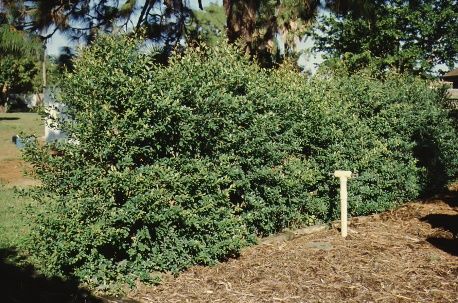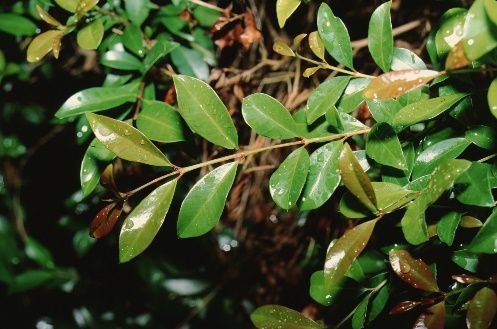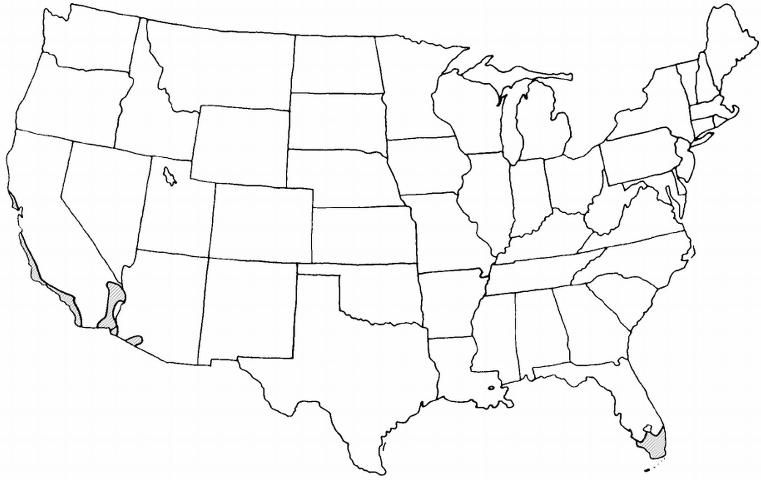Introduction
Brush cherry has beautiful reddish foliage when it first emerges. The shiny leaves slowly turn dark green on thin brown twigs. Older plants eventually reach to about 12 feet tall, but most are clipped into hedges in residential landscapes.
Showy white flowers borne in the warm months are usually pruned off and not very noticeable, but flowers on unclipped plants are quite attractive as they fill the canopy. Several stems arise from the lower part of the tree, forming a multiple trunked tree well adapted for many landscapes. The plant may still be referred to as Eugenia myrtifolia in some catalogues.

Credit: Edward F. Gilman, UF/IFAS

Credit: Edward F. Gilman, UF/IFAS

Credit: Edward F. Gilman, UF/IFAS

Credit: Edward F. Gilman, UF/IFAS
General Information
Scientific name: Syzygium paniculatum
Pronunciation: sizz-ZYE-gee-um pan-nick-yoo-LAY-tum
Common name(s): brush cherry
Family: Myrtaceae
Plant type: tree
USDA hardiness zones: 10 through 11 (Figure 5)
Planting month for zone 10 and 11: year-round
Origin: native to Florida
Invasive potential: not known to be invasive
Uses: container or above-ground planter; near a deck or patio; superior hedge; small parking lot islands (< 100 square feet in size); medium-sized parking lot islands (100–200 square feet in size); large parking lot islands (> 200 square feet in size); narrow tree lawns (3–4 feet wide); medium-sized tree lawns (4–12 to 20 feet 6 feet wide); wide tree lawns (>6 feet wide); recommended for buffer strips around parking lots or for median strip plantings in the highway; screen
Availability: somewhat available, may have to go out of the region to find the plant

Credit:
Description
Height: 12 to 20 feet
Spread: 8 to 15 feet
Plant habit: vase shape; oval
Plant density: moderate
Growth rate: moderate
Texture: fine
Foliage
Leaf arrangement: opposite/subopposite
Leaf type: simple
Leaf margin: entire
Leaf shape: elliptic (oval)
Leaf venation: none, or difficult to see
Leaf type and persistence: evergreen
Leaf blade length: less than 2 inches
Leaf color: purple or red
Fall color: no fall color change
Fall characteristic: not showy
Flower
Flower color: white
Flower characteristic: summer flowering
Fruit
Fruit shape: round
Fruit length: less than 0.5 inch
Fruit cover: fleshy
Fruit color: red; black
Fruit characteristic: suited for human consumption; attracts birds
Trunk and Branches
Trunk/bark/branches: typically multi-trunked or clumping stems; showy
Current year stem/twig color: reddish
Current year stem/twig thickness: thin
Culture
Light requirement: plant grows in part shade/part sun
Soil tolerances: acidic; alkaline; sand; loam; clay
Drought tolerance: high
Soil salt tolerances: unknown
Plant spacing: 36 to 60 inches
Other
Roots: usually not a problem
Winter interest: no special winter interest
Outstanding plant: plant has outstanding ornamental features and could be planted more
Pest resistance: no serious pests are normally seen on the plant
Use and Management
The most common use of brush cherry is for a tall screen or hedge. Small leaves, year-round growth and a natural compact habit make this one of the premier hedge plants in south Florida. It is also nicely suited for espalier or topiary. Drought tolerance and nice foliage make it a nice addition to a deck or patio when planted in a container.
Trees can be trained in the nursery to one central trunk or allowed and encouraged to develop multiple trunks as plants age. The bark on these older trunks is quite showy. Brush cherry creates shade for a patio or deck, but will not grow to the large, often overpowering size of a large tree such as a fig. They can be used along streets, in highway medians, and in parking lots because they adapt to small soil spaces and do not become very large. Street and parking lot trees are often specified to have one trunk to allow for vehicle clearance beneath the crown. Multiple trunked trees are often specified for specimen planting, so the beautiful bark can be displayed.
Brush cherry grows well in south Florida on limestone soils as an understory plant. However, it is perfectly adapted to more open, sunny locations where it will flourish with little care once it becomes established.
Pests and Diseases
Scales and mites can infest the foliage and twigs.